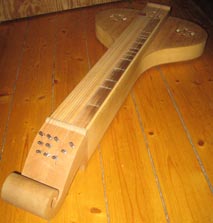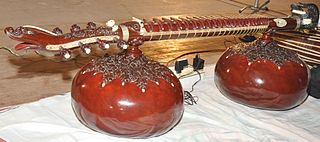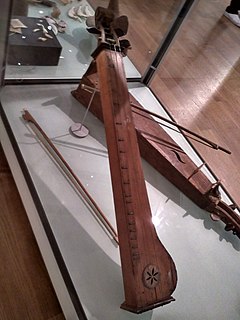
Zither is a class of stringed instruments. Historically, the name has been applied to any instrument of the psaltery family, or to an instrument consisting of many strings stretched across a thin, flat body. This article describes the latter variety.

An autoharp or chord zither is a string instrument belonging to the zither family. It uses a series of bars individually configured to mute all strings other than those needed for the intended chord. The term autoharp was once a trademark of the Oscar Schmidt company, but has become a generic designation for all such instruments, regardless of manufacturer.

The langeleik, also called langleik, is a Norwegian stringed folklore musical instrument, a droned zither.

The Appalachian dulcimer is a fretted string instrument of the zither family, typically with three or four strings, originally played in the Appalachian region of the United States. The body extends the length of the fingerboard, and its fretting is generally diatonic.

The hummel is an old Northern European stringed instrument similar to an older type of zither and is related to the Norwegian langeleik. The name is thought to come from the German word hummel, meaning "bumblebee", referring to the droning sound created by the accompaniment strings.
In music, a drone is a harmonic or monophonic effect or accompaniment where a note or chord is continuously sounded throughout most or all of a piece. A drone may also be any part of a musical instrument used to produce this effect; an archaic term for this is burden such as a "drone [pipe] of a bagpipe", the pedal point in an organ, or the lowest course of a lute. Α burden is also part of a song that is repeated at the end of each stanza, such as the chorus or refrain.

The swarmandal, surmandal or Indian harp is a plucked box zither, originating from the Indian subcontinent, similar to the qanun that is today most commonly used as an accompanying instrument for vocal Indian classical music. It is part of the culture of Northern India, used in concerts to accompany vocal music. The name combines Sanscrit words svara (notes) and maṇḍala (circle), representing its ability to produce many notes. The instrument may be the same as the 13th century 21-string instrument called the mattakokilā. The instrument was seen as equivalent by Ā'īn-i-akbarī in the Mughal period to the qanun.

Ektara is a one-stringed musical instrument used in the traditional music of South Asia, and used in modern-day music of Bangladesh, India, and Pakistan.

Kokle or historically kokles (kūkles) is a Latvian plucked string instrument (chordophone) belonging to the Baltic box zither family known as the Baltic psaltery along with Lithuanian kanklės, Estonian kannel, Finnish kantele, and Russian gusli. The first possible kokles related archaeological findings in the territory of modern Latvia are from the 13th century, while the first reliable written information about kokles playing comes from the beginning of the 17th century. The first known kokles tune was notated in 1891, but the first kokles recordings into gramophone records and movies were made in 1930s. Both kokles and kokles playing are included in the Latvian Culture Canon.

The Rudra veena —also called Bīn in North India—is a large plucked string instrument used in Hindustani classical music, especially dhrupad. It is one of the major types of veena played in Indian classical music, notable for its deep bass resonance.
Non-religious secular music and sacred music were the two main genres of Western music during the Middle Ages and Renaissance era. The oldest written examples of secular music are songs with Latin lyrics. However, many secular songs were sung in the vernacular language, unlike the sacred songs that followed the Latin language of the Church. These earliest types were known as the chanson de geste and were popular amongst the traveling jongleurs and minstrels of the time.

A psalterium, or tambourin à cordes, is an ancient stringed musical instrument, the name of which is synonymous with the psaltery. In specific usage, this name denotes a form of long psaltery that is tuned to provide drone chords. Sometimes called a "string drum", though not to be confused with a friction drum also called a "string drum", it is usually used as rhythm accompaniment with a form of tabor pipe. It is also known as tambourin de Béarn or Tambourin de Gascogne in French, ttun-ttun[cunˈcun] in Basque, salmo in Spanish, and chicotén in Aragonese.
The shahi baaja is an electrified and slightly modified version of the Indian bulbul tarang, a type of Indian zither to which have been added typewriter keys which depress several of the strings to change their pitch. The modifications also include the addition of 12 additional unfretted strings which serve as an attached swarmandal.

The épinette des Vosges is a traditional plucked-string instrument of the zither family, whose use was confined to two areas in the Vosges mountains of France approximately 50 km apart: around Val-d'Ajol and around Gérardmer.

The scheitholt or scheitholz is a traditional German stringed instrument and an ancestor of the modern zither. It falls into the category of drone zithers.

The langspil is a traditional Icelandic drone zither. It has a single melody string and usually 2 drone strings.
The kolitong is a bamboo polychordal tube zither from Bontok, Kalinga, Philippines with six strings that run parallel to its tube body. The strings are numbered from one to six, from lowest to highest pitch. The body acts as the instrument's resonator. The body may be a whole tube or a half tube. In both cases, the two ends of the body are closed by the bamboo nodes. To help with the resonance of the instrument, holes are made on both nodes and long cracks are made along the body parallel to the strings.

The veena, also spelled vina, comprises a family of chordophone instruments from the Indian subcontinent. Ancient musical instruments evolved into many variations, such as lutes, zithers and arched harps. The many regional designs have different names such as the Rudra veena, the Saraswati veena, the Vichitra veena and others.

The tube zither is a stringed musical instrument in which a tube functions both as an instrument's neck and its soundbox. As the neck, it holds strings taut and allows them to vibrate. As a soundbox or it modifies the sound and transfers it to the open air. The instruments are among the oldest of chordophones, being "a very early stage" in the development of chordophones, and predate some of the oldest chordophones, such as the Chinese Se, zithers built on a tube split in half. Most tube zithers are made of bamboo, played today in Madagascar, India, Southeast Asia and Taiwan. Tube zithers made from other materials have been found in Europe and the United States, made from materials such as cornstalks and cactus.

A raft zither is a group of single-cord tube zithers, connected together to form a "raft". Tube zithers use a tube as a platform to hold a string, raised with bridges.

















